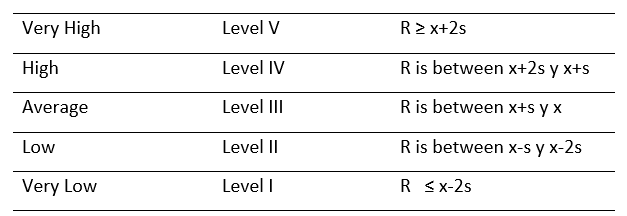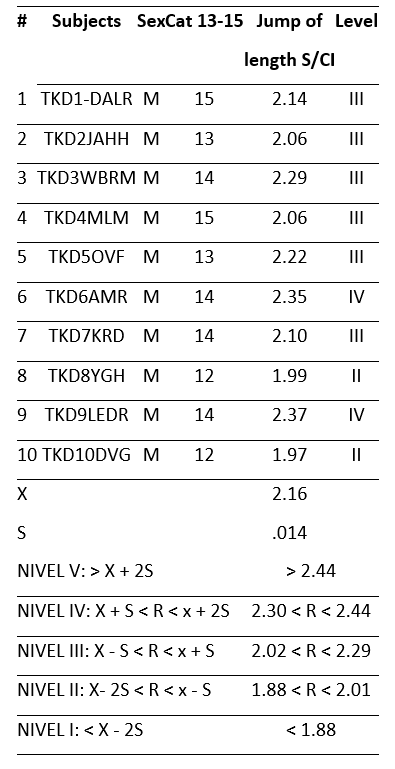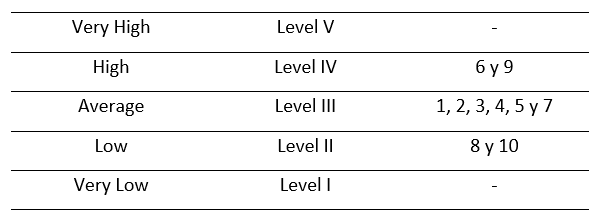

Ciencia y Deporte. Vol. 9. No. 3, September -December, 2024, p.e294.
Original article
The selection of school-aged Taekwondo talents based on explosive strength levels
La selección de talentos taekwondistas escolares según los niveles de fuerza explosiva
A seleção de talentos escolares de taekwondo de acordo com os níveis de força explosiva
Laritza Columbié Rivera1*![]() Isabel Fleitas Díaz1
Isabel Fleitas Díaz1![]() ,
Alfredo Quintana Díaz2*
,
Alfredo Quintana Díaz2*![]() , Liudmila Hernández Soutelo3*
, Liudmila Hernández Soutelo3*![]()
1Manuel Fajardo University of Sciences of Physical Culture and Sport. Havana, Cuba.
2Manuel Fajardo University of Sciences of Physical Culture and Sport. Havana, Cuba.
3Cuban Sports Research Center. Havana, Cuba.
4University of Oriente. Faculty of Physical Culture. Santiago de Cuba, Cuba.
*Corresponding author: columbie.tkd@gmail.com
Received: 29/05/2024
Accepted: 09/08/2024
ABSTRACT
Introduction: Taekwondo predominantly utilizes explosive techniques; therefore,
understanding the development level of this capacity is crucial for selecting talented individuals in this
discipline. While explosive strength alone does not determine talent, it is a factor to consider.
However, theoretical and methodological insufficiencies were detected in sporting practice.
Objective: To determine the levels of explosive strength in school-aged Taekwondo athletes
for talent selection.
Materials and methods: The theoretical methods employed were analytical-synthetic
and inductive-deductive. Empirical methods included documentary analysis, surveys,
and measurements. Descriptive statistics, using mean and standard deviation, were employed
as mathematical-statistical methods.
Results: The standing long jump test was administered to 10 Taekwondo athletes. After
obtaining individual results, the group mean and standard deviation were calculated to determine
the corresponding levels for each athlete.
Conclusions: By determining the performance levels of the Taekwondo athletes, the coach
has benchmark values to set goals for training and workload assimilation for their athletes.
Keywords: Physical capacity, talent selection, combat sports.
RESUMEN
Introducción: en el taekwondo existe un predominio de técnicas con carácter explosivo, por lo que
se hace necesario conocer el nivel de desarrollo de esta capacidad como primicia fundamental
al seleccionar talentos para esta disciplina. Aunque la fuerza explosiva no determina por si sola al
posible talento, es un factor a tener en consideración. Sin embargo, se detectó insuficiencias
teórico-metodológicas en la práctica deportiva.
Objetivo: determinar los niveles de fuerza explosiva en taekwondistas
escolares para seleccionar los talentos deportivos.
Materiales y métodos: se emplearon como métodos teóricos de la investigación científica el
analítico-sintético y el inductivo-deductivo. De los empíricos, el análisis documental, la encuesta y
medición. Como métodos matemático-estadísticos, la estadística descriptiva, con la media y desviación estándar.
Resultados: el test de salto de longitud sin carrera de
impulso se le aplicó a 10 taekwondistas, una
vez obtenido el resultado individual se halló la media y desviación estándar del grupo para determinar
los niveles a los que correspondían cada uno de ellos.
Conclusiones: al determinar los niveles de comportamiento de los resultados de los taekwondistas,
el entrenador tiene los valores de correspondencia para trazarse metas sobre el trabajo y la
asimilación de las cargas de sus deportistas.
Palabras clave: capacidad física, selección de talentos, deportes de combate.
RESUMO
Introdução: no taekwondo há predominância de técnicas de caráter explosivo, por isso é necessário conhecer o nível de desenvolvimento desta habilidade como um primeiro passo fundamental na seleção de talentos para esta disciplina. Embora a força explosiva por si só não determine o talento potencial, é um factor a ter em consideração. Entretanto, foram detectadas insuficiências teórico-metodológicas na prática esportiva.
Objetivo: determinar os níveis de força explosiva em praticantes escolares de taekwondo para seleção de talentos esportivos.
Materiais e métodos: métodos analítico-sintéticos e indutivo-dedutivos foram utilizados como métodos teóricos de pesquisa científica. Dos empíricos, a análise documental, o levantamento e a mensuração. Como métodos matemático-estatísticos, utiliza-se a estatística descritiva, com média e desvio padrão.
Resultados: o teste de salto em distância sem corrida de impulso foi aplicado a 10 jogadores de taekwondo. Uma vez obtido o resultado individual, foi encontrada a média e o desvio padrão do grupo para determinar os níveis aos quais cada um deles correspondia.
Conclusões: ao determinar os níveis comportamentais dos resultados dos jogadores de taekwondo, o treinador tem os valores correspondentes para traçar metas de trabalho e assimilação das cargas de seus atletas.
Palavras-chave: capacidade física, seleção de talentos, esportes de combate.
INTRODUCTION
Taekwondo in Cuba is a traditionally medal-winning sport in the Olympic Games, which is why it is considered a strategic sport. Its achievements include six Olympic medals, demonstrating the consistency and preparation of its athletes (Montejo et al., 2014).
These results are supported by the infrastructure of Cuban sports, and Taekwondo in particular. The planning of Taekwondo training for each of the phases of long-term sport preparation is continuously designed and restructured from the Integral Program for the Preparation of the Athlete (PIPD by its acronym in Spanish), which is composed of four levels:
The 13-15 year-old age group in Taekwondo marks the beginning of the high-performance pyramid, and one specific objective of the Program for the Preparation of the Athlete (PIPD) is the appropriate selection of athletic talent. One aspect to consider in talent selection is physical capacity, both general and specific (Quintana & Quintana, 2023)
In this regard, Morales et al. (2023) give greater importance to lower-body explosive strength, considering it one of the most crucial conditional capacities to develop due to the numerous explosive actions performed in combat. This involves achieving acceleration in strikes with jumps, turns, and the Taekwondo athlete's movements. However, the logical specifics of this content are still insufficient in the school-age category.
According to Alberto & Moreno (2018), Romero et al. (2020), Díaz et al. (2023), and Antunes et al. (2024), explosive strength is the amount of internal force that the neuromuscular system can mobilize per unit of time (speed and amount of force developed) and the duration of this force. Explosive strength is one of the main forces used in sports requiring rapid, explosive, and ballistic movements, as it is the first force utilized in quick and precise actions. However, these studies lack specific methods and tests to consider in athletic selection.
In-depth studies on this topic, such as that by Bacuilima et al. (2023), highlight the limited management of the talent search and selection process in young Taekwondo athletes. This is due to the scarcity of records showing the use of physical, anthropometric, or psychological tests within sporting organizations. Consequently, this has led athletes to stagnate at a certain point in their competitive stage, limiting their potential for long-term national and international achievements.
Other authors, such as Sánchez et al. (2020), Muñoz et al. (2022), and Jiménez et al. (2024), explain that the selection of athletic talent is a top priority for federations, clubs, and sports schools worldwide, particularly emphasizing the urgent need for talent selection in combat sports. However, according to Orellana et al. (2022), the methodology applied to select Taekwondo talent is limited to recruitment through invitations to practice the sport, lacking scientific backing and relying on the coach's empirical judgment based on wins in official and unofficial competitions during the athlete's identification, selection, and training phases.
These elements demonstrate the need for a scientific reference to determine the explosive strength levels of female Taekwondo athletes for sports selection and their correspondence with current competitive demands. Therefore, this research aimed to determine the levels of explosive strength in school-aged female Taekwondo athletes to select athletic talent.
MATERIALS AND METHODS
This study was conducted in La Habana province, Cuba, at the Mártires de Barbados Sports Initiation School (EIDE). The research was carried out with Taekwondo athletes in the school category (ages 13-15), with a sample size of ten Taekwondo athletes. Four coaches working with this category served as information sources. They have over eight years of coaching experience, are black belts, 2nd dan, with two holding bachelor's degrees and two holding master's degrees in Sports Training.
The following scientific methods were employed:
From a theoretical level, the analytical-synthetic method was used to delve into all stages of the research process. The inductive-deductive method was used for a comprehensive understanding of the research problem, supported by current documents from relevant institutions.
At the empirical level, the documentary analysis method was used, allowing for a bibliographic review of background studies related to the subject matter. The review consulted research articles published in national and international journals and normative documents (PIPD) on Taekwondo.
A survey technique was applied to understand how the explosive strength levels of school-aged Taekwondo athletes were determined. This involved open and closed-ended questions designed to gather as much information as possible on the procedures used for explosive strength testing and evaluation.
Measurement was employed using the standing long jump test. The objective was to determine the lower limb explosive strength of the school-aged Taekwondo athletes. The materials used were a measuring tape and chalk or adhesive tape to mark the jump line.
Methodological steps for performing the test
The subject stands behind the marked line with their feet slightly apart. In the phase preceding the jump, they may swing their arms and bend their knees to gain greater impetus. The jump should be initiated with both feet and landed similarly, maintaining foot placement and the initial point of contact, maintaining balance without using their hands for support. Measurement is taken from the heel of the foot closest to the starting line.
1. Independent scoring.
2. All test results are processed using:
Using these statistics, the behavior of each individual within a group can be evaluated, provided they are part of it and meet the conditions guaranteeing their membership. In this specific case, the group would consist of all 13-15 year-olds belonging to the EIDE.
In order to apply consistently the selection criterion, the subject must demonstrate overall behavior at levels IV and V, guaranteeing that they possess aptitudes and attitudes significantly superior to the population.
The application of these central tendency statistics allows the establishment of the following behavior levels (Table 1):
Table 1. - Central Tendency Statistics

Source: Own elaboration
Legend:
R: Result of the element's behavior within the
group, in this case, the child's behavior in a
specific indicator.
X: Average (mean) behavior of all individuals in the study population.
S: Standard deviation; the dispersion of each individual's behavior with respect to the
average behavior of the study population.
To apply consistently the selection criteria, it is required that the Taekwondo practitioner demonstrates overall behavior at levels V and VI. These levels guarantee that the individual possesses aptitudes and attitudes significantly superior to the general population.
Descriptive statistical methods, such as the mean and standard deviation (central tendency and dispersion statistics), were used to process the results. These statistics describe how the values are distributed, and how close or far they are from the mean. SPSS version 10.0 for Windows was used as the software for performing the statistical analysis of the mean and standard deviation of the obtained results.
RESULTS AND DISCUSSION
Analysis of the survey administered to the four coaches revealed the following:
Analyzing the coaches' responses, the tests proposed by Zatsiorski (1989) were applied and the evaluation was conducted to determine the levels of the Taekwondo practitioners and to enable talent selection based on these results (Table 2).
Table 2. - Results of the standing long jump test applied to Taekwondo practitioners

Source: Own elaboration
Analysis of the results determined the levels of the Taekwondo practitioners (Table 3).
Table 3. - Results showing the levels of Taekwondo practitioners

Source: Own elaboration
Considering the talent selection criteria, which requires results above the population average, it was determined that only Taekwondo athletes 6 and 9 are at level IV. Most are within the average, and two are below average, requiring continued work.
By determining the performance levels relative to the population the coach works with, the corresponding values for each Taekwondo athlete can be established, allowing for the setting of goals regarding training and the assimilation of training loads.
The Cuban Taekwondo talent selection system in the initial specialization phase (13-15 years) evaluates performance capacity, readiness for performance, and training capacity through established indicators. It also includes a balance factor that weighs cases of delayed development. Therefore, all evaluations are integrated to establish a comprehensive criterion for each athlete's status and define levels that allow a selection criterion to be issued (Zatsiorsky, 1989; Bacuilima et al., 2023; Morales et al., 2023).
Conversely, other authors (Alberto & Moreno, 2018; Muñoz et al., 2022; Orellana et al., 2022) argue for the implementation of multidimensional models that consider performance capacity, training capacity, and readiness for performance, based on the characteristics of the sport and the biological development phase of the practitioners. This includes considering the pace of improvement in the most relevant aptitudes and the relationship between chronological and biological age of Taekwondo athletes during the initial specialization phase.
Consequently, given the different approaches adopted by the aforementioned researchers, it can be argued that the epistemological limitations detected in their contributions reveal insufficient methodological procedures. Hence the relevance of this research.
CONCLUSIONS
The systematization of the consulted literature allowed us to address the conceptualization of terms such as sports talent and demonstrated the insufficiencies in the topic of explosive strength in sports selection.
The surveys conducted with coaches revealed deficiencies in referencing the levels of lower limb explosive strength among school-aged Taekwondo athletes for talent selection. Evaluations are currently conducted individually, without any guidance on how to select talent in this category.
Explosive strength results were analyzed and distributed into levels according to the proposed scale. Of the total population, only two Taekwondo athletes were identified as sporting talents based on this test.
BIBLIOGRAPHIC REFERENCES
Alberto Cardozo, L., & Moreno Jiménez, J. (2018). Valoración de la Fuerza Explosiva en Deportistas de Taekwondo: Una Revisión Sistemática. Kronos. https://g-se.com/valoracion-de-la-fuerza-explosiva-en-deportistas-de-taekwondo-una-revision -sistematica-2430-sa-y5b4e14fcec173
Antunes Emiliano, M. F., Porto López, F. F., & Tandrón Negrín, B. (2024). Ejercicios pliométricos para desarrollar fuerza explosiva y potencia muscular en judocas jóvenes en Angola. Acción, 19(No.1), 16-31. https://accion.uccfd.cu/index.php/accion/article/view/276
Bacuilima Solis, J. C., García Herrera, D. G., & Ávila Mediavilla, C. M. (2023). Criterios en la detección de talentos deportivos para el Taekwondo en edades tempranas. Revista Conrado, 19(92), 170-177. https://conrado.ucf.edu.cu/index.php/conrado/article/view/3017
Díaz Cevallos, A. C., Reina Palma, L. E., Marcela Romero, D., & Macas, J. (2023). Ejercicio Pliométrico: mecanismo para incrementar la Fuerza Explosiva en futbolistas Sub-16. Arrancada, 23(45), 135-150. https://revistarrancada.cujae.edu.cu/index.php/arrancada/article/view/610
Jiménez Fernández, G. Y., Hernández Horta, G., Vila Machado, M., & Regalado Toledo, C. M. (2024). Propuesta de indicadores para la selección de atletas en poomsae para el alto rendimiento. Validación práctica. PODIUM - Revista De Ciencia Y Tecnología En La Cultura Física, 19(1), e1515. https://podium.upr.edu.cu/index.php/podium/article/view/1515
Montejo Poll, D., Pavón Flores, Y., Columbié Rivera, L., & González Estrada, J.A. (2014). Análisis de la participación del taekwondo en los Juegos Olímpicos. EFDeportes.com, Revista Digital. Buenos Aires, 34 (188). https://www.efdeportes.com/efd188/taekwondo-en-los-juegos-olimpicos.htm
Morales Futiel, M., González Ramírez, J.L., & Méndez Infante, H.A. (2023). Particularidades del entrenamiento de la fuerza explosiva en la etapa especial de los taekwondistas juveniles. Cultura Física Y Deportes De Guantánamo, 13(22). https://famadeportes.cug.co.cu:443/index.php/Deportes/article/view/537
Muñoz Alemán, N., Díaz Catalá, A. R., Montalvo Triana, A., & González Estrada, J. A. (2022). La puesta a punto en el Taekwondo de alto rendimiento: Revisión sistemática. Acción, 18(s/n). https://accion.uccfd.cu/index.php/accion/article/view/223
Orellana Coraizaca, M.E., García Herrera, D.G., & Ávila Mediavilla, C.M. (2022). Selección de talentos deportivos en deportes de combate. CASEDELPO, 7 (9). https://mail.polodelconocimiento.com/ojs/index.php/es/article/view/4611
Quintana Parra, A., & Quintana Díaz, A. (2023). Organización didáctica del Programa Integral de Preparación en deportes de combate. Acción, 19(s/n). https://accion.uccfd.cu/index.php/accion/article/view/258
Romero Frómeta, E., Aymara Cevallos, V.D., & Rojas Portero, J.M. (2020). Efectos de la pliometría en la fuerza explosiva de miembros inferiores en la lucha libre senior. Rev Cubana Invest Bioméd 39 (1). http://scielo.sld.cu/scielo.php?script=sci_arttext&pid=S0864-03002020000100018
Sánchez, B., Lastres, A., Arias, E., Mesa, M., Vidaurreta, R., & García, L. (2020). Deportes de combate, hacia un modelo de finalidad táctica de selección de talentos. Revista PODIUM, 15(3). http://scielo.sld.cu/pdf/rpp/v15n3/1996-2452-rpp-15-03-389.pdf
Zatsiorsky, V. M. (1989). Metrología deportiva: Libro de texto. Planeta. https://books.google.com.cu/books/about/Metrolog%C3%ADa_deportiva.html?i d=P45WPQAACAAJ&redir_esc=y
Conflict of interest statement:
The authors declare having competing interests.
Author contribution statement:
The authors have participated in the redaction of the manuscript and the documentary review.
![]()
This paper is distributed under the terms of the Licencia CreativeCommons (CC) 4.0. (CC BY-NC-SA 4.0)
Copyright (c) 2024
Laritza Columbié Rivera, Isabel Fleitas Díaz,
Alfredo Quintana Díaz, Liudmila Hernández Soutelo